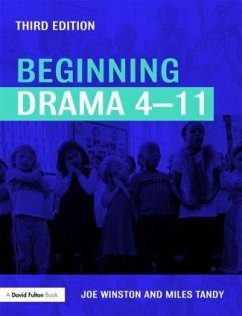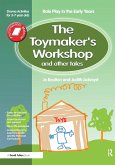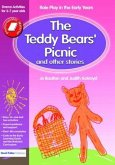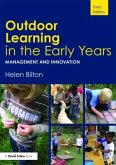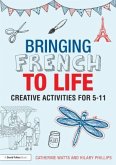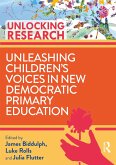- Broschiertes Buch
- Merkliste
- Auf die Merkliste
- Bewerten Bewerten
- Teilen
- Produkt teilen
- Produkterinnerung
- Produkterinnerung
Gives an introduction for early years and primary school teachers who are new to drama and for student teachers who wish to specialise in the teaching of drama. This work offers guidance to help teachers and children grow in confidence in their use of drama, and shows how drama can contribute to work in English, and learning across the curriculum.
Andere Kunden interessierten sich auch für
![The Toymaker's workshop and Other Tales The Toymaker's workshop and Other Tales]() Jo BoultonThe Toymaker's workshop and Other Tales40,99 €
Jo BoultonThe Toymaker's workshop and Other Tales40,99 €![The Teddy Bears' Picnic and Other Stories The Teddy Bears' Picnic and Other Stories]() BoultonThe Teddy Bears' Picnic and Other Stories40,99 €
BoultonThe Teddy Bears' Picnic and Other Stories40,99 €![Outdoor Learning in the Early Years Outdoor Learning in the Early Years]() Helen BiltonOutdoor Learning in the Early Years31,99 €
Helen BiltonOutdoor Learning in the Early Years31,99 €![Storytelling and Market Research Storytelling and Market Research]() C. Frederic JohnStorytelling and Market Research35,99 €
C. Frederic JohnStorytelling and Market Research35,99 €![Humanistic Geography and Literature (RLE Social & Cultural Geography) Humanistic Geography and Literature (RLE Social & Cultural Geography)]() Humanistic Geography and Literature (RLE Social & Cultural Geography)64,99 €
Humanistic Geography and Literature (RLE Social & Cultural Geography)64,99 €![Bringing French to Life Bringing French to Life]() Catherine Watts (UK University of Brighton)Bringing French to Life47,99 €
Catherine Watts (UK University of Brighton)Bringing French to Life47,99 €![Unleashing Children's Voices in New Democratic Primary Education Unleashing Children's Voices in New Democratic Primary Education]() Unleashing Children's Voices in New Democratic Primary Education27,99 €
Unleashing Children's Voices in New Democratic Primary Education27,99 €-
-
-
Gives an introduction for early years and primary school teachers who are new to drama and for student teachers who wish to specialise in the teaching of drama. This work offers guidance to help teachers and children grow in confidence in their use of drama, and shows how drama can contribute to work in English, and learning across the curriculum.
Hinweis: Dieser Artikel kann nur an eine deutsche Lieferadresse ausgeliefert werden.
Hinweis: Dieser Artikel kann nur an eine deutsche Lieferadresse ausgeliefert werden.
Produktdetails
- Produktdetails
- Verlag: David Fulton Publishers Ltd
- 3 ed
- Seitenzahl: 146
- Erscheinungstermin: 3. Oktober 2008
- Englisch
- Abmessung: 246mm x 189mm x 8mm
- Gewicht: 312g
- ISBN-13: 9780415475839
- ISBN-10: 041547583X
- Artikelnr.: 23819879
- Herstellerkennzeichnung
- Libri GmbH
- Europaallee 1
- 36244 Bad Hersfeld
- gpsr@libri.de
- Verlag: David Fulton Publishers Ltd
- 3 ed
- Seitenzahl: 146
- Erscheinungstermin: 3. Oktober 2008
- Englisch
- Abmessung: 246mm x 189mm x 8mm
- Gewicht: 312g
- ISBN-13: 9780415475839
- ISBN-10: 041547583X
- Artikelnr.: 23819879
- Herstellerkennzeichnung
- Libri GmbH
- Europaallee 1
- 36244 Bad Hersfeld
- gpsr@libri.de
Joe Winston is Associate Professor (Reader) in Drama and Theatre Education, University of Warwick, and a leading international writer, speaker and trainer in the field of primary drama. Miles Tandy is an Adviser for Warwickshire Educational Development Service, working in the area of drama, literacy and primary curriculum development.
Preface to the Third Edition Introduction Drama is playful Dramas use
stories to explore issues of human significance In drama, the normal rules
of time, place and identity are suspended Drama is a social activity and a
communal art form Drama is driven by rules and conventions Dramas should
not be boring 1. Beginning drama with games Games and how they relate to
drama Games which involve movement in space Games for pairs and small
groups Circle games Games which suggest stories Some strategies to help
with organisation and control 2. Beginning drama with a story: The Forest
Child 'Keeper of the Keys' (Year 1 upwards) Previewing the story (Reception
upwards) Presenting the story (Reception upwards) Acting out the story
(Year 1 upwards) Making a map of the story (Year 2 upwards) Creating the
forest through sound (Year 3 upwards) Creating the forest through movement
(Year 4 upwards) Showing the worst moment for the Forest Child (Year 2
upwards) Questioning the Hunter (Year 2 upwards) A meeting of the animals
of the forest (Year 2 upwards) Revisiting the sounds of the forest (Year 3
upwards) How might this new story end? (Year 4 upwards) Planning a drama
lesson: some basic considerations 3. Beginning drama in the early years
Planning for imaginative play The drama lesson in the early years 4. Drama
in the curriculum Example 1 - The 3 Pigs' Homes Points to consider Example
2 - The Terracotta Army Points to consider Example 3 - The Saxons and the
Viking Raids Points to consider Example 4 - Building the Reservoir Points
to consider Example 5 - The Siege of Troy Points to consider A framework
for planning to teach drama Learning area Key questions Intended learning
outcomes Starting point Outline of activity Further questions / activity
Managing the pace and direction of the drama Moving the thinking on:
teacher questioning in the drama lesson 5. Drama and literacy Example 1 -
The Three Billy Goats Gruff (Reception / Y1) Example 2 - Giggle, Giggle,
Quack (Year 2/3) Example 3 - Arthur (Year 4) Example 4 - Quetta (Year 5)
Example 5 - Romeo and Juliet (Year 6) 6. Drama, community and performance
in the primary school Example 1: The Enchanter's Daughter (Year 6) Example
2: The Snow Queen (Year 2) Some guidelines for those new to running school
drama productions 7. Progression, continuity and assessment in primary
drama First principles of progression Progression and continuity in drama
within the personal, social and moral curriculum Making, performing and
responding Learning objectives specific to drama Policy and practice
Publications referred to in this chapter Appendix 1 The Forest Child
Appendix 2 A selection of drama conventions Bibliography Index
stories to explore issues of human significance In drama, the normal rules
of time, place and identity are suspended Drama is a social activity and a
communal art form Drama is driven by rules and conventions Dramas should
not be boring 1. Beginning drama with games Games and how they relate to
drama Games which involve movement in space Games for pairs and small
groups Circle games Games which suggest stories Some strategies to help
with organisation and control 2. Beginning drama with a story: The Forest
Child 'Keeper of the Keys' (Year 1 upwards) Previewing the story (Reception
upwards) Presenting the story (Reception upwards) Acting out the story
(Year 1 upwards) Making a map of the story (Year 2 upwards) Creating the
forest through sound (Year 3 upwards) Creating the forest through movement
(Year 4 upwards) Showing the worst moment for the Forest Child (Year 2
upwards) Questioning the Hunter (Year 2 upwards) A meeting of the animals
of the forest (Year 2 upwards) Revisiting the sounds of the forest (Year 3
upwards) How might this new story end? (Year 4 upwards) Planning a drama
lesson: some basic considerations 3. Beginning drama in the early years
Planning for imaginative play The drama lesson in the early years 4. Drama
in the curriculum Example 1 - The 3 Pigs' Homes Points to consider Example
2 - The Terracotta Army Points to consider Example 3 - The Saxons and the
Viking Raids Points to consider Example 4 - Building the Reservoir Points
to consider Example 5 - The Siege of Troy Points to consider A framework
for planning to teach drama Learning area Key questions Intended learning
outcomes Starting point Outline of activity Further questions / activity
Managing the pace and direction of the drama Moving the thinking on:
teacher questioning in the drama lesson 5. Drama and literacy Example 1 -
The Three Billy Goats Gruff (Reception / Y1) Example 2 - Giggle, Giggle,
Quack (Year 2/3) Example 3 - Arthur (Year 4) Example 4 - Quetta (Year 5)
Example 5 - Romeo and Juliet (Year 6) 6. Drama, community and performance
in the primary school Example 1: The Enchanter's Daughter (Year 6) Example
2: The Snow Queen (Year 2) Some guidelines for those new to running school
drama productions 7. Progression, continuity and assessment in primary
drama First principles of progression Progression and continuity in drama
within the personal, social and moral curriculum Making, performing and
responding Learning objectives specific to drama Policy and practice
Publications referred to in this chapter Appendix 1 The Forest Child
Appendix 2 A selection of drama conventions Bibliography Index
Preface to the Third Edition Introduction Drama is playful Dramas use
stories to explore issues of human significance In drama, the normal rules
of time, place and identity are suspended Drama is a social activity and a
communal art form Drama is driven by rules and conventions Dramas should
not be boring 1. Beginning drama with games Games and how they relate to
drama Games which involve movement in space Games for pairs and small
groups Circle games Games which suggest stories Some strategies to help
with organisation and control 2. Beginning drama with a story: The Forest
Child 'Keeper of the Keys' (Year 1 upwards) Previewing the story (Reception
upwards) Presenting the story (Reception upwards) Acting out the story
(Year 1 upwards) Making a map of the story (Year 2 upwards) Creating the
forest through sound (Year 3 upwards) Creating the forest through movement
(Year 4 upwards) Showing the worst moment for the Forest Child (Year 2
upwards) Questioning the Hunter (Year 2 upwards) A meeting of the animals
of the forest (Year 2 upwards) Revisiting the sounds of the forest (Year 3
upwards) How might this new story end? (Year 4 upwards) Planning a drama
lesson: some basic considerations 3. Beginning drama in the early years
Planning for imaginative play The drama lesson in the early years 4. Drama
in the curriculum Example 1 - The 3 Pigs' Homes Points to consider Example
2 - The Terracotta Army Points to consider Example 3 - The Saxons and the
Viking Raids Points to consider Example 4 - Building the Reservoir Points
to consider Example 5 - The Siege of Troy Points to consider A framework
for planning to teach drama Learning area Key questions Intended learning
outcomes Starting point Outline of activity Further questions / activity
Managing the pace and direction of the drama Moving the thinking on:
teacher questioning in the drama lesson 5. Drama and literacy Example 1 -
The Three Billy Goats Gruff (Reception / Y1) Example 2 - Giggle, Giggle,
Quack (Year 2/3) Example 3 - Arthur (Year 4) Example 4 - Quetta (Year 5)
Example 5 - Romeo and Juliet (Year 6) 6. Drama, community and performance
in the primary school Example 1: The Enchanter's Daughter (Year 6) Example
2: The Snow Queen (Year 2) Some guidelines for those new to running school
drama productions 7. Progression, continuity and assessment in primary
drama First principles of progression Progression and continuity in drama
within the personal, social and moral curriculum Making, performing and
responding Learning objectives specific to drama Policy and practice
Publications referred to in this chapter Appendix 1 The Forest Child
Appendix 2 A selection of drama conventions Bibliography Index
stories to explore issues of human significance In drama, the normal rules
of time, place and identity are suspended Drama is a social activity and a
communal art form Drama is driven by rules and conventions Dramas should
not be boring 1. Beginning drama with games Games and how they relate to
drama Games which involve movement in space Games for pairs and small
groups Circle games Games which suggest stories Some strategies to help
with organisation and control 2. Beginning drama with a story: The Forest
Child 'Keeper of the Keys' (Year 1 upwards) Previewing the story (Reception
upwards) Presenting the story (Reception upwards) Acting out the story
(Year 1 upwards) Making a map of the story (Year 2 upwards) Creating the
forest through sound (Year 3 upwards) Creating the forest through movement
(Year 4 upwards) Showing the worst moment for the Forest Child (Year 2
upwards) Questioning the Hunter (Year 2 upwards) A meeting of the animals
of the forest (Year 2 upwards) Revisiting the sounds of the forest (Year 3
upwards) How might this new story end? (Year 4 upwards) Planning a drama
lesson: some basic considerations 3. Beginning drama in the early years
Planning for imaginative play The drama lesson in the early years 4. Drama
in the curriculum Example 1 - The 3 Pigs' Homes Points to consider Example
2 - The Terracotta Army Points to consider Example 3 - The Saxons and the
Viking Raids Points to consider Example 4 - Building the Reservoir Points
to consider Example 5 - The Siege of Troy Points to consider A framework
for planning to teach drama Learning area Key questions Intended learning
outcomes Starting point Outline of activity Further questions / activity
Managing the pace and direction of the drama Moving the thinking on:
teacher questioning in the drama lesson 5. Drama and literacy Example 1 -
The Three Billy Goats Gruff (Reception / Y1) Example 2 - Giggle, Giggle,
Quack (Year 2/3) Example 3 - Arthur (Year 4) Example 4 - Quetta (Year 5)
Example 5 - Romeo and Juliet (Year 6) 6. Drama, community and performance
in the primary school Example 1: The Enchanter's Daughter (Year 6) Example
2: The Snow Queen (Year 2) Some guidelines for those new to running school
drama productions 7. Progression, continuity and assessment in primary
drama First principles of progression Progression and continuity in drama
within the personal, social and moral curriculum Making, performing and
responding Learning objectives specific to drama Policy and practice
Publications referred to in this chapter Appendix 1 The Forest Child
Appendix 2 A selection of drama conventions Bibliography Index

